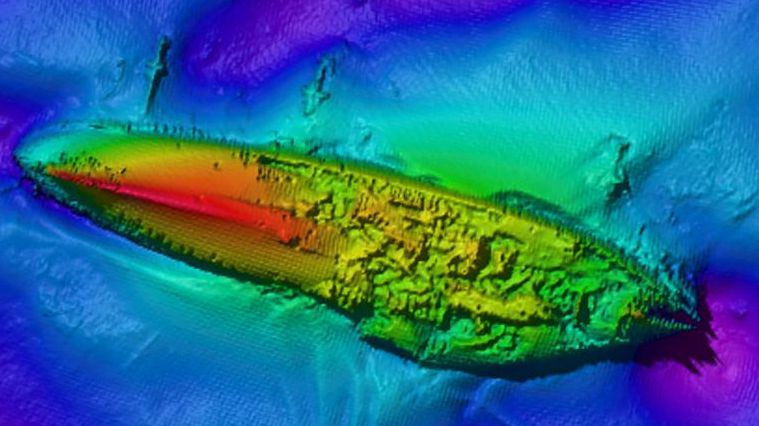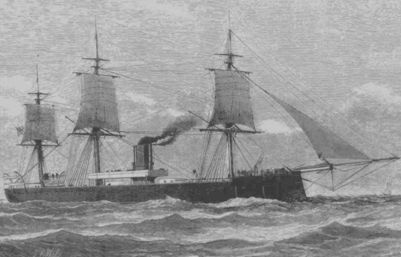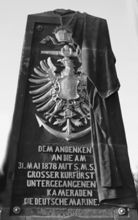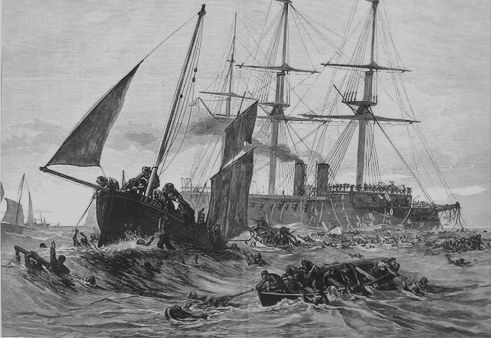31st
May 1878 GROSSER KURFURST Sunk
off Folkestone
|
|
|
SMS Grosser Kurfürst
was an ironclad turret ship of the German Kaiserliche Marine. She
was laid down at the Imperial Dockyard in Wilhelmshaven in 1870 and
completed in 1878; her long construction time was in part due to a
redesign that was completed after work on the ship had begun.
Her main battery
of four 26 cm (10 in) guns was initially to be placed in a central
armored battery, but during the redesign this was altered to a pair
of twin gun turrets amidships. (wiki)
|
|
|
On May 31st 1878,
while three German warships were holding an exercise in the channel,
the "Grosser Kurfurst" and the "Koenig Wilhelm"
found themselves on a collision course as they changed direction to
avoid a Norwegian barque.
The German turret
ironclad warship "Grosser Kurfurst" which had been sent
out on her maiden voyage on 29th May 1878, was rammed by "Konig
Wilhelm" as she tore away she left a 20 foot long by 14 feet
wide opening on "Grosser Kurfust" port side in her armour
plating below the waterline. She went down with 287 lives.
The German government
in 1881 erected a stone obelisk memorial to the mass grave in Folkestone's
Cheriton Road cemetery.
|
-
REMEMBER THE GROSSER
KURFURST -
Sunk
off Folkestone on
31st May 1878
|
Feuerwerker LANGE
Oberbootsmannsmaat SCHRAMM
Oberbootsmannsmaat WEISS
Bootsmannsmaat MACZIEWSKY
Bootsmannsmaat PLATH
Bootsmannsmaat SAUKE
Bootsmannsmaat SCHNEIDER
Ober Fw. Maat HENSEL
Ober Fw. Maat RÜBNER
Fw. Maat HAGEN
Schreiber (Maat) MEYER
Obermaat BORGSTAHL
Obermaat BRECKWOLDT
Obermaat CHRISTIANSEN
Obermaat EBEL
Obermaat ERDMANN
Obermaat FELTER
Obermaat HARWICH
Obermaat PAUSTIAN
Obermaat SASS
Obermaat STRATHMANN
Obermaat WAHRHEIT
Maat APEL
Maat BACKHAUS
Maat BÄCKERMANN
Maat BAHR
Maat BARNSDORF
Maat BAUMANN
Maat BECKER
Maat BEICKE
Maat BENSEN
Maat BOCK
Maat BÖNING
Maat BOTHE
Maat BRÄSCH
Maat BRÖHAN
Maat BROSE
Maat BRUHN
Maat BRUHN
Maat CAMP
Maat CHRISTIANSEN
Maat DAASE
Maat DAHL
Maat DECKER
Maat DUIT
Maat ERICH
Maat EWEN
Maat FENNEKOHL
Maat GRAWE gnt. FISCHER
Maat FÖH
Maat FOLKERS
Maat FRERICHS
Maat GERRETS
Maat GIERLOFF
Maat GÖRCKE
Maat GREGOR
Maat GRUBER
Maat GÜLTZAU
Maat HÄKEL
Maat HARTZ
Maat HASHAGEN
Maat HAUSCHILD
Maat HEIN
Maat HEINTZ
Maat HEITMANN
Maat HERRMANN
Maat HESSENIUS
Maat HILLMANN
Maat HINTZ
Maat HOLSTEIN
Maat HORN
Maat HUCKFELDT
Maat JANSSEN
Maat JANSSEN
Maat JULIUS
Maat KAUT
Maat KLEBB
Maat KLUCKIST
Maat DEHN gnt. KOCK
Maat KRABBE
Maat KRUSE
Maat von LENGEN
Maat LEUCHTER
Maat LOHSE
Maat LORENZ
Maat MAAKE
Maat MEYER
Maat MIESEGADES
Maat MORITZ
Maat MÜLLER
Maat MÜLLER
Maat MÜNSTER
Maat MÜNZER
Maat MUMM
Maat NAUKEMANN
Maat NEUHAUS
Maat NEUMANN
Maat NISSEN
Maat NOORMANN
Maat von OESEN
Maat OSTERKAMP
Maat PAHL
Maat PLATTE
Maat POHL
Maat POHLMANN
Maat PREGEL
Maat RAHDE
Maat RANKENBURG
Maat RATHMANN
Maat RAVE
Maat ROTHE
Maat SCHIPMANN
Maat SCHMDIT
Maat SCHOONE
Maat SCHÜDDE
Maat SCHUH
Maat SCHUHMACHER
Maat SEEGER
Maat SIEBKE
Maat SPANGENBERG
Maat STALLBAUM
Maat STUBBE
Maat STURM
Maat TÖRNER
Maat TREDERSDORF
Maat VISSER
Maat WALDEMAR
Maat WERNICKE
Maat WICHMANN
Maat WILHELM
Maat WISCH
Maat WITT
Maat WOLTMANN
30.05.1878, Folkstone S.M.S. Grosser Kurfürst
|
|
This
shipwreck is protected
The wreck has
been scheduled and added to the National Heritage List for England.
Scheduling means that recreational divers have permission to dive
the wreck but its contents are given a level of protection. The
associated memorial at Cheriton Road Cemetery in Folkestone has
been listed at Grade II. Spring 2020.
|
|
From
Wessex Archaeology dated 5th September 2019: On Friday, subject to
weather, a Wessex Archaeology dive team will begin a non-intrusive
survey of the wreck of the Grosser Kurfürst for Historic England.
Using data supplied by the UKHO, our marine geophysicists have processed
this multibeam sonar plan-view image of the wreck. Although it is
partially collapsed, you can see that the hull is upside-down, just
as the historical records suggest the ship sank. However, this data
does not tell us everything and, using hand-held imaging sonar and
sharp eyes, our divers will be trying to answer a number of questions
about this large wreck.
|
|

Wessex
Sonar Image:-
|
As an ‘ironclad’,
the ship is from a revolutionary period in naval warfare in which
navies moved from reliance upon wooden to armoured ships and which
saw the emergence of the forerunners of the great Dreadnought battleships
of the First World War. It was a highly experimental time that briefly
saw the return of the ancient ram, but ended with the dominance of
armour plate and the big gun. It is rare for European ocean-going
ironclad warships to be studied archaeologically, so we hope that
this work will contribute to our knowledge of this fascinating period
in naval history.
|
Coastal Heritage
Note: The wreck is upside down on the seabe. To stop
the dead bodies from being washed up on the beaches, a number of nets
was put on the wreck to keep the dead in the vessel,and the area was
a dumping ground for clinker (used to coal from railway ships).
Divers have
died while visiting this shipwreck.
|
| |
|
|
|
|
|
|
|
|
|
|
|
|
|
|
|
|
|
|







